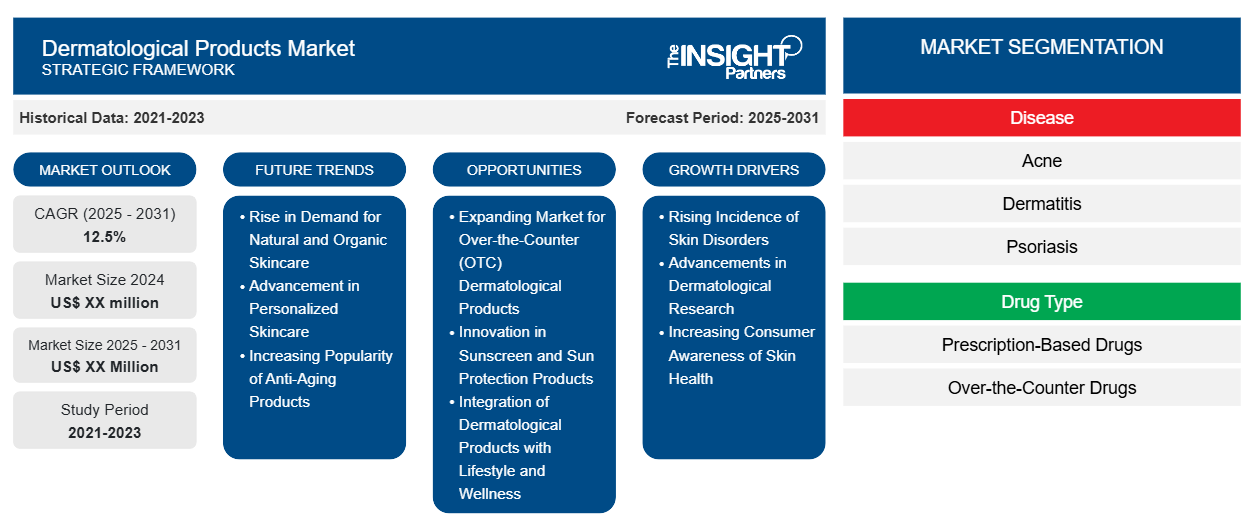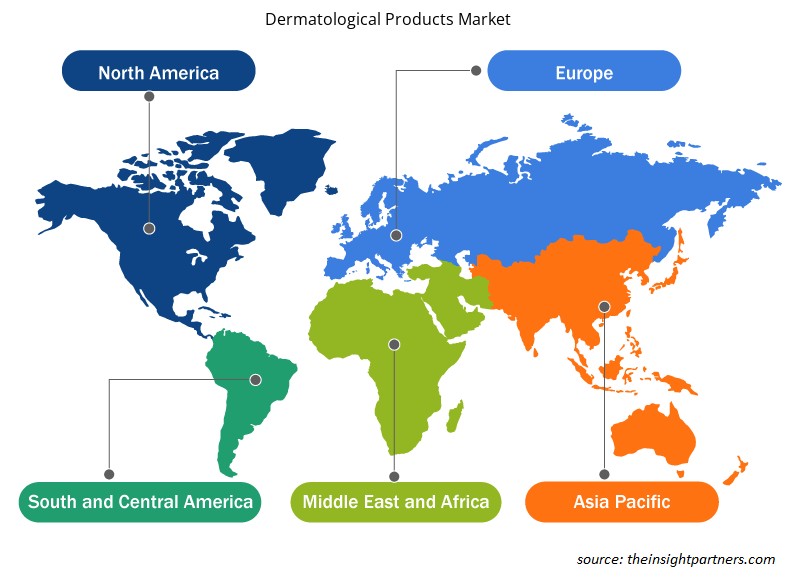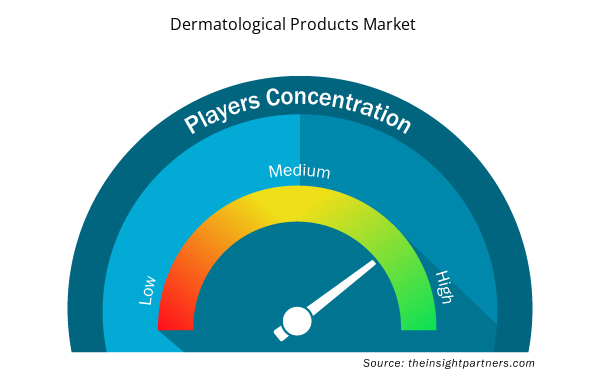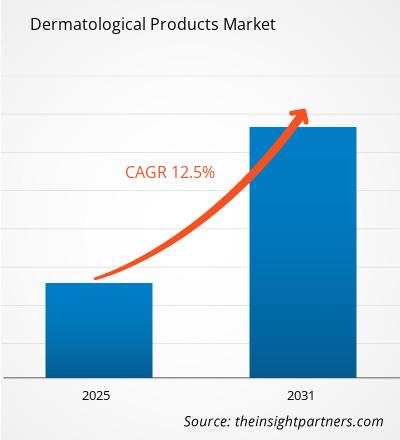The Dermatological Products Market is expected to register a CAGR of 12.5% from 2025 to 2031, with a market size expanding from US$ XX million in 2024 to US$ XX Million by 2031.
The report is segmented by Disease (Acne, Dermatitis, Psoriasis, Skin Cancer, Rosacea, Alopecia, Others); Drug Type (Prescription-Based Drugs, Over-the-Counter Drugs); Gender Type (Female, Male). The global analysis is broken down at the regional level and for major countries. The market evaluation is presented in US$ for the above segmental analysis.
Purpose of the Report
The report Dermatological Products Market by The Insight Partners aims to describe the present landscape and future growth, top driving factors, challenges, and opportunities. This will provide insights to various business stakeholders, such as:
- Technology Providers/Manufacturers: To understand the evolving market dynamics and know the potential growth opportunities, enabling them to make informed strategic decisions.
- Investors: To conduct a comprehensive trend analysis regarding the market growth rate, market financial projections, and opportunities that exist across the value chain.
- Regulatory bodies: To regulate policies and police activities in the market with the aim of minimizing abuse, preserving investor trust and confidence, and upholding the integrity and stability of the market.
Dermatological Products Market Segmentation
Disease
- Acne
- Dermatitis
- Psoriasis
- Skin Cancer
- Rosacea
- Alopecia
Drug Type
- Prescription-Based Drugs
- Over-the-Counter Drugs
Gender Type
- Female
- Male
Customize This Report To Suit Your Requirement
You will get customization on any report - free of charge - including parts of this report, or country-level analysis, Excel Data pack, as well as avail great offers and discounts for start-ups & universities
Dermatological Products Market: Strategic Insights

- Get Top Key Market Trends of this report.This FREE sample will include data analysis, ranging from market trends to estimates and forecasts.
Dermatological Products Market Growth Drivers
- Rising Incidence of Skin Disorders: The increasing prevalence of dermatological conditions such as acne, eczema, psoriasis, and skin cancer is a significant driver for the dermatological products market. Skin disorders, particularly acne, affect a large portion of the global population, both in adolescents and adults, creating a substantial demand for treatment products. Additionally, the incidence of skin diseases like eczema and psoriasis is rising due to factors such as environmental pollution, poor lifestyle choices, and genetics. As the demand for effective treatments grows, the dermatological products market is expected to expand rapidly. Products such as topical treatments, oral medications, and biologic therapies for conditions like psoriasis are gaining traction, helping to improve patient outcomes. Market size forecasts indicate that skin-related diseases will continue to contribute to the growth of the dermatological products market, as consumers seek more advanced solutions.
- Advancements in Dermatological Research: Ongoing advancements in dermatological research are driving the development of more effective, safe, and targeted skincare treatments. Research into molecular biology and skin physiology has enabled the creation of more sophisticated products tailored to specific skin concerns. New active ingredients, improved formulations, and cutting-edge technologies such as nanotechnology are enhancing the efficacy of dermatological products. Additionally, with increasing understanding of how certain conditions impact skin health, targeted therapies for chronic conditions like acne, rosacea, and skin aging are becoming more personalized. These advancements are expected to fuel the market size of dermatological products, as consumers and healthcare professionals alike opt for treatments that provide faster and longer-lasting results.
- Increasing Consumer Awareness of Skin Health: As people become more aware of the importance of skincare and the potential risks of neglecting skin health, there has been a notable surge in the demand for dermatological products. Consumer education regarding the long-term effects of sun exposure, pollution, and aging has increased the adoption of skincare products for protection, prevention, and treatment. With a greater focus on both aesthetic concerns and medical skincare, there is an increasing trend of consumers seeking professional dermatological products, which has led to an overall expansion in the market. The growing interest in self-care, combined with the influence of social media and beauty influencers, has also contributed to the rising demand for dermatological products, including anti-aging solutions, moisturizers, and sunscreens.
Dermatological Products Market Future Trends
- Rise in Demand for Natural and Organic Skincare: Consumers are increasingly turning toward natural and organic skincare products due to growing concerns about the potential long-term effects of chemicals and synthetic ingredients. With rising awareness regarding the risks of harsh chemicals in skincare, more individuals are opting for dermatological products that are free from parabens, sulfates, and artificial fragrances. This trend is driving the development of plant-based and all-natural formulations that cater to consumers seeking gentle yet effective skincare solutions. Market forecasts indicate that natural and organic skincare products will continue to gain market share, as they are perceived to be safer and more environmentally friendly. As a result, companies are incorporating botanical extracts, essential oils, and other organic ingredients into their dermatological products to cater to this growing segment.
- Advancement in Personalized Skincare: Personalization is becoming a significant trend in the dermatological products market. Advances in technology, particularly in areas such as artificial intelligence (AI) and genetic testing, are enabling brands to offer more personalized skincare solutions. By analyzing an individual’s skin type, genetic makeup, and lifestyle, personalized skincare products can be tailored to provide the most effective results. This trend is gaining momentum as consumers seek more targeted treatments that address their unique skin needs. Personalized skincare products may include custom-formulated creams, serums, and cleansers, and even treatments for specific conditions like acne or aging. With the rise of at-home skincare devices and DNA-based skin tests, this trend is set to continue driving innovation and market growth in dermatology.
- Increasing Popularity of Anti-Aging Products: The global aging population, coupled with increased demand for youth-preserving treatments, has made anti-aging skincare one of the most lucrative segments in the dermatological products market. Products designed to reduce wrinkles, fine lines, and sagging skin are in high demand, especially among middle-aged and older consumers. The effectiveness of ingredients like retinoids, peptides, hyaluronic acid, and antioxidants in combating skin aging has led to the growing popularity of anti-aging skincare products. Moreover, with consumers increasingly seeking non-invasive cosmetic procedures, there is a rising demand for dermatological products that can complement these treatments. Anti-aging skincare products are projected to remain a dominant trend in the dermatological products market, with new formulations continuously entering the market to meet the evolving needs of consumers.
Dermatological Products Market Opportunities
- Expanding Market for Over-the-Counter (OTC) Dermatological Products: The growing trend toward self-medication and increased consumer access to healthcare information is opening up substantial opportunities in the over-the-counter (OTC) dermatological products market. OTC products for common skin conditions such as acne, eczema, and dry skin are seeing widespread adoption. Consumers are increasingly turning to OTC options for managing mild to moderate conditions, which has created a thriving market for products like medicated creams, ointments, sunscreens, and moisturizers. This shift toward self-care is driving demand for convenient, accessible, and affordable skincare solutions. As more consumers seek effective treatments without the need for prescriptions, the OTC dermatological products market is expected to grow significantly, presenting opportunities for brands to expand their product offerings.
- Innovation in Sunscreen and Sun Protection Products: Sunscreen and sun protection products are a critical segment within the dermatological products market, as consumers become more aware of the harmful effects of UV radiation on skin health. As a result, there is an increasing demand for high-quality, broad-spectrum sunscreens that offer both protection and added skincare benefits. Innovations in sunscreen formulations, such as mineral-based sunscreens and products with added antioxidants or anti-aging properties, are expected to drive the growth of this segment. Additionally, the rising awareness of skin cancer and the importance of UV protection is leading to increased adoption of sunscreen products globally. The growing focus on sun protection as part of daily skincare routines represents a significant growth opportunity within the dermatological products market.
- Integration of Dermatological Products with Lifestyle and Wellness: The integration of dermatological products with overall wellness and lifestyle is a growing opportunity for brands. As consumers increasingly view skincare as part of their broader health and wellness routines, dermatological products are being marketed alongside other wellness-related items such as dietary supplements, fitness products, and stress management tools. Brands are beginning to emphasize holistic skincare, integrating dermatological products with other lifestyle products aimed at improving overall well-being. For example, supplements that support skin health, along with skincare treatments designed to work in harmony with a balanced lifestyle, are becoming more popular. This trend is likely to expand the reach of dermatological products, particularly as consumer interest in wellness continues to rise globally.
Dermatological Products Market Regional Insights
The regional trends and factors influencing the Dermatological Products Market throughout the forecast period have been thoroughly explained by the analysts at Insight Partners. This section also discusses Dermatological Products Market segments and geography across North America, Europe, Asia Pacific, Middle East and Africa, and South and Central America.

- Get the Regional Specific Data for Dermatological Products Market
Dermatological Products Market Report Scope
| Report Attribute | Details |
|---|---|
| Market size in 2024 | US$ XX million |
| Market Size by 2031 | US$ XX Million |
| Global CAGR (2025 - 2031) | 12.5% |
| Historical Data | 2021-2023 |
| Forecast period | 2025-2031 |
| Segments Covered |
By Disease
|
| Regions and Countries Covered | North America
|
| Market leaders and key company profiles |
Dermatological Products Market Players Density: Understanding Its Impact on Business Dynamics
The Dermatological Products Market market is growing rapidly, driven by increasing end-user demand due to factors such as evolving consumer preferences, technological advancements, and greater awareness of the product's benefits. As demand rises, businesses are expanding their offerings, innovating to meet consumer needs, and capitalizing on emerging trends, which further fuels market growth.
Market players density refers to the distribution of firms or companies operating within a particular market or industry. It indicates how many competitors (market players) are present in a given market space relative to its size or total market value.
Major Companies operating in the Dermatological Products Market are:
- Bayer AG,
- Johnson & Johnson,
- Pfizer Inc.,
- Novartis AG,
- GlaxoSmithKline plc,
- AstraZeneca,
Disclaimer: The companies listed above are not ranked in any particular order.

- Get the Dermatological Products Market top key players overview
Key Selling Points
- Comprehensive Coverage: The report comprehensively covers the analysis of products, services, types, and end users of the Dermatological Products Market, providing a holistic landscape.
- Expert Analysis: The report is compiled based on the in-depth understanding of industry experts and analysts.
- Up-to-date Information: The report assures business relevance due to its coverage of recent information and data trends.
- Customization Options: This report can be customized to cater to specific client requirements and suit the business strategies aptly.
The research report on the Dermatological Products Market can, therefore, help spearhead the trail of decoding and understanding the industry scenario and growth prospects. Although there can be a few valid concerns, the overall benefits of this report tend to outweigh the disadvantages.
- Historical Analysis (2 Years), Base Year, Forecast (7 Years) with CAGR
- PEST and SWOT Analysis
- Market Size Value / Volume - Global, Regional, Country
- Industry and Competitive Landscape
- Excel Dataset



Report Coverage
Revenue forecast, Company Analysis, Industry landscape, Growth factors, and Trends

Segment Covered
This text is related
to segments covered.

Regional Scope
North America, Europe, Asia Pacific, Middle East & Africa, South & Central America

Country Scope
This text is related
to country scope.
Frequently Asked Questions
The Dermatological Products Market is estimated to witness a CAGR of 12.5% from 2025 to 2031.
The major factors driving the Dermatological Products Market are Rising Incidence of Skin Disorders, Advancements in Dermatological Research, Increasing Consumer Awareness of Skin Health.
Future trends in the Dermatological Products Market are Rise in Demand for Natural and Organic Skincare, Advancement in Personalized Skincare, Increasing Popularity of Anti-Aging Products.
Some of the players operating in the market are Bayer AG, Johnson & Johnson, Pfizer Inc., Novartis AG, GlaxoSmithKline plc, AstraZeneca, Galderma S.A., Amgen Inc., AbbVie Inc., Merck KGaA
The report can be delivered in PDF/PPT format; we can also share an excel datasheet based on the request.
Some customization options available based on the request are an additional 3–5 company profiles and a country-specific analysis of 3–5 countries of your choice. Customizations are to be requested/discussed before making final order confirmation# as our team would review the same and check the feasibility.
Trends and growth analysis reports related to Life Sciences : READ MORE..
1. Bayer AG
2. Johnson & Johnson
3. Pfizer Inc.
4. Novartis AG
5. GlaxoSmithKline plc
6. AstraZeneca
7. Galderma S.A.
8. Amgen Inc.
9. AbbVie Inc.
10. Merck KGaA
11. Avon Products, Inc.
12. Shiseido Co., Ltd.
13. Ikeda Mohando Co Ltd
14. Taisho Pharmaceutical
15. Perrigo Company Plc
16. Emami Ltd.
17. Pierre Fabre SA

 Get Free Sample For
Get Free Sample For